
Principle: To prepare, ferment or preserve all food on site
A kitchen is a place used to prepare, ferment or preserve food. It is the end-stage of the garden: the place where plants and animals become food. In permaculture, kitchens are also one of the most visible reflections of the community’s values: what it eats, how it cooks.
Kitchen elements
When designing a kitchen, it is important to allow enough space to prepare, cook serve and preserve food. One strategy is to design your refrigerator, stove top and sink within a few meters of each other.
The following elements conserve energy and enable you to prepare great home-cooked meals from your garden.
Cob oven
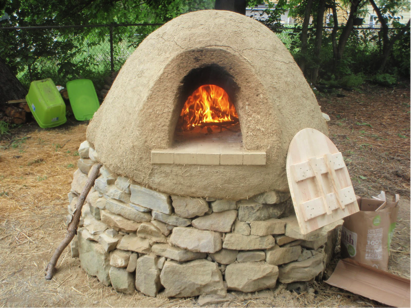
A cob oven is a fuel-efficient method of baking. Cob has high-insulating properties, which trap heat inside the oven,
thus the heat recirculates.
How to make a cob oven
- Choose a location near your kitchen and build a base with earth, rocks or bricks until you reach the desired height
- Arrange flat stone(s) to be the base of the oven. On top of the flat stone, mound wet sand in the shape you want the oven and cover the sand with wet newspaper
- Lay an even layer of cob, about 5cm, on top of the sand
- Cover to protect from rain and sun, it could crack if it dries too fast. Let it dry overnight. Once the cob has dried, now you dig out the sand from the door opening
- Once you pull out all the sand, make a fire inside to burn off all the newspaper, and then make a fire and cook a pizza!
- There are many design variations for cob ovens. Look online for one you like.
Fuel-efficient stoves
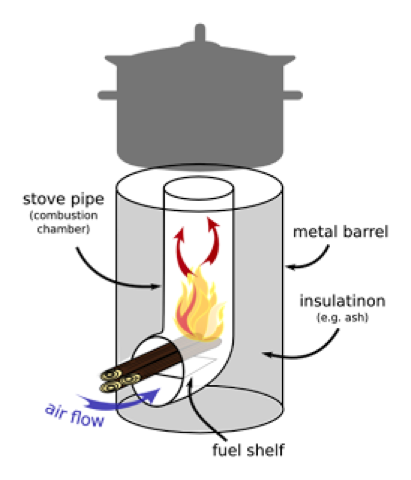
People cook food using many different methods. Natural gas works well, but can be expensive. Almost half of the world’s population cook using wood. This method makes food taste great and keeps the kitchen dry and insect-free. However, wood is a limited or costly resource and the fumes from the smoke cause significant lung damage. The following types of fuel-efficient stoves illustrate methods to reduce the amount of wood needed for cooking.
Rocket stoves
Typical rocket stove design
www.stv-dshr.blogspot.in/2013/02/rocket-stoves-and-bio-char-at-florida.html
Rocket bread oven
Capturing Heat: Aprovecho, (www.aprovecho.net)
Multi-function rocket stove
The design below is a concept to create tunnels of cob and create either multi-burner stoves and or channel the heat into ducts to go throughout the house.
Solar cooker
Solar cookers work great on sunny days. They do take a few hours, so be prepared to put your food in early in the day. It’s nice to eat dinner at the end of the day by opening up a hot pot of fresh food cooked from the sun.
www.ecoenergy.org.ua/sdelay-sam/samodelnaya-solnechnaya-kuxnya.html
Dutch Oven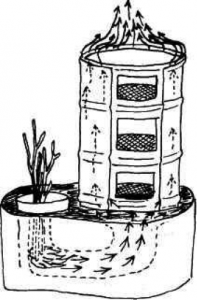
A Dutch oven is a cast iron pot and lid. You can make a big pot of something you want to cook/bake, place in a fire, put on the lid and cover it with coals. It is a good, fuel-efficient way to cook a nice slow cooked roast.
Hay box
A hay box is a highly insulated box used for keeping things hot for a long time. It can be as simple as a 200-liter metal drum, filled with sand, straw or even heavy blankets, leaving a space to put the pot and a thick insulated lid. To cook rice using a hay box, first, boil the rice and water on the stove. Let it boil for 2-3 minutes then remove it from the heat and put it in the hay box for 30-45 minutes. Once you finish cooking the rest of the meal, the rice is ready. You can steep teas if making wine or kombucha, or use it to keep food warm while you prepare the rest of the meal.
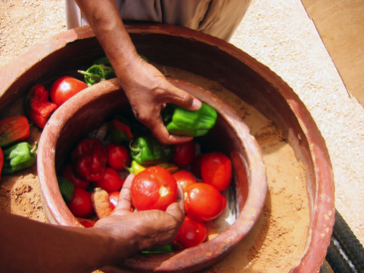 Clay refrigerator
Clay refrigerator
The Zeer pot refrigerator is a clay pot filled with wet sand, then capped with a smaller pot inside and capped with a good fitting clay top. This refrigerator has proven to extend the life of crops 10 times compared to traditional storage practices. Results of using a Zeer pot versus normal shelf life (test case in Sudan from Zeer pot website):
Tomatoes 2 days 20 days
Guavas 2 days 20 days
Okra 4 days 17 days
Carrots 4 days 20 days
Rocket 1 day 5 days
Plate-washing station
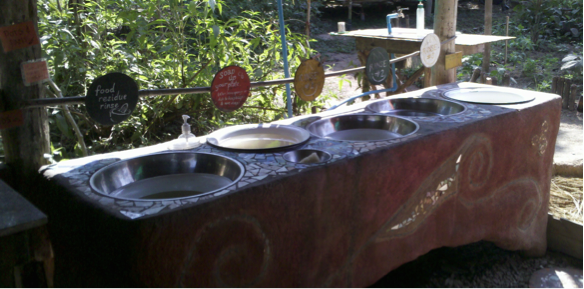
A 5-bowl washing system saves a tremendous amount of water. In the first bowl, you rinse off food residue. In the second bowl, wash your dish with soap and a sponge. In the last three bowls rinse off the soap. By the time your dish reaches the last bowl, it will be clean and you can hang it on the drying rack. Run the drain water into your greywater system (see water for a simple grease trap).
Cleaning note: You can clean just about anything with these three items:
- Lemon/lime
- Vinegar
- Baking soda
Fermentation
Fermentation is the chemical breakdown of a substance. This process converts sugar to acids, gases and alcohol. The fermentation process occurs in yeast and bacteria, but also in oxygen-starved muscle cells, as in the case of lactic acid fermentation.
Fermentation is where we turn basic vegetables into more complex foods. This chapter includes recipes for simple fermentation experiments you can do at home and become your own brew master.
Here are a few foods you can ferment. For full recipes and good descriptions of what you can ferment, (Wild Fermentation by Sandor Katz):
- Vegetables – Sauerkraut/kimchi, ginger beer, tempeh, miso
- Fruits/honey – Wine, cider, vinegar, kombucha
- Grains – Beer, sourdough, porridge
- Milk – Yogurt, kefir, cheese, cream, buttermilk, butter
- Household products– Soap, toothpaste, shampoo, conditioner
Here are some simple fermentation recipes:
Mead / T’ej / Ethiopian honey wine
- Mix 3 cups of honey with 12 cups of water (always 4 :1 ratio, water : honey) in a wide-mouth container.
- Cover with a towel or cloth
- Set aside in warm room for 3-4 days
- Stir mix at least twice a day (more the better)
- Once it’s bubbly, transfer into small mouth container(s)
- Seal and apply airlock
- Leave for 2-4 weeks, until bubbling slows
Ginger bug (for ginger beer)
- Mix ½ cup of water + 2 teaspoons of ginger (skin and all) + 2 teaspoons of sugar + lime juice
- Let it sit, every 2-3 days add 1 teaspoon of ginger and 1 teaspoon of sugar
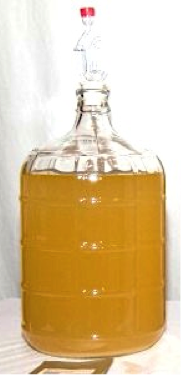
Homemade wine
- 2 liters of water – dissolve 750g of sugar
- If using fruit (you can use less sugar),
- Boil for 30 minutes
- Let cool, add yeast or leave open to absorb yeast from air
- Leave out overnight, bubbles should appear
- Sieve liquid into airlock containers,
- Apply airlock
- 5-6 weeks bubbling will stop
Fruit scrap vinegar
- 1 liter of water + ¼ cup of sugar (60mL) + fruit scraps, finely-chopped (pineapple works great, as does any other fruit scrap)
- Cover with cloth, store at room temperature
- After 1 week, strain fruit scraps and discard
- Ferment liquid 2-3 weeks
Sourdough
- Mix 1 cup of water + 1 cup of flour in a bowl
- Stir well
- Cover with a cheesecloth or towel
- Leave for 1 week, stirring at least twice a day
- When it starts to bubble and smell sour, you can use it
- Use half of the starter at a time to make a batch of sourdough
- When you break the starter in half, feed the remaining starter the same amount of flour and water you removed